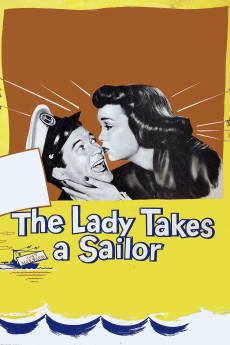The Lady Takes a Sailor (1949) – Academic and Psychological Review
The Lady Takes a Sailor (1949) – Academic and Psychological Review
Academic Review
The Lady Takes a Sailor is a 1949 action/comedy/romance film directed by Michael Curtiz. This academic review explores various aspects of the film, analyzing its narrative structure, character development, and thematic depth.
Plot Summary
The film follows the story of Jennifer Smith (Jane Wyman), a career-driven woman who is thrown into a whirlwind of comedic and romantic escapades when she encounters sailor Bill Craig (Dennis Morgan). Their unexpected meeting leads to a series of humorous and adventurous events, testing Jennifer’s professional and personal boundaries.
Characters and Acting
Jane Wyman delivers a charming performance as Jennifer, capturing the character’s blend of independence and vulnerability. Dennis Morgan’s portrayal of Bill Craig is equally engaging, providing a perfect counterbalance to Wyman’s character. The chemistry between the two leads drives the film’s narrative and adds depth to their comedic interactions.
Direction
Michael Curtiz’s direction is masterful, blending elements of comedy, romance, and action seamlessly. Curtiz’s ability to balance these genres while maintaining a coherent and engaging storyline is a testament to his directorial prowess. His use of visual storytelling techniques enhances the film’s overall impact.
Cinematography
The cinematography by Ted D. McCord captures the film’s vibrant and lively atmosphere. The use of wide shots and dynamic camera angles adds a sense of adventure and excitement, particularly during the action sequences. The film’s visual style complements its comedic and romantic elements, creating a cohesive aesthetic.
Music and Score
The musical score by Max Steiner is both whimsical and romantic, perfectly fitting the film’s tone. Steiner’s compositions enhance the emotional resonance of key scenes, contributing to the overall enjoyment of the film. The soundtrack adds a layer of charm and nostalgia to the viewing experience.
Themes
The film explores themes of love, adventure, and self-discovery. Jennifer’s journey from a career-focused individual to someone who embraces spontaneity and romance is central to the narrative. The film also touches on the theme of finding balance between professional ambitions and personal happiness.
Screenplay and Dialogue
The screenplay, written by Everett Freeman, is witty and engaging. The dialogue is sharp and humorous, with memorable lines that contribute to the film’s comedic charm. The interplay between Jennifer and Bill is particularly well-written, capturing the nuances of their evolving relationship.
Special Effects
The film’s special effects, though modest by today’s standards, are effective in enhancing the action sequences. The practical effects and stunts are well-executed, adding to the film’s adventurous spirit. The use of visual effects is sparing but impactful, complementing the overall narrative.
Editing and Pacing
The editing by Folmar Blangsted ensures a smooth and coherent narrative flow. The pacing of the film is well-balanced, allowing for both comedic and dramatic moments to shine. The transitions between scenes are seamless, maintaining the viewer’s engagement throughout.
Production Design
The production design by Anton Grot is detailed and immersive, creating a vivid and lively setting for the film’s events. The sets are meticulously crafted, reflecting the film’s blend of realism and whimsy. The attention to detail in the production design enhances the overall aesthetic of the film.
Historical Accuracy
While the film is not primarily focused on historical events, its depiction of post-war America is notable. The film reflects the societal changes and cultural shifts of the late 1940s, providing a glimpse into the era’s attitudes and values. The historical context adds depth to the film’s narrative and characters.
Overall Impressions
The Lady Takes a Sailor is a delightful and engaging film that successfully blends comedy, romance, and action. Its charming performances, sharp writing, and skillful direction make it a standout entry in the genre. The film’s exploration of themes such as love and self-discovery resonates with audiences, ensuring its enduring appeal.
Rating and Recommendation
Overall, The Lady Takes a Sailor receives a rating of 8/10. It is recommended for fans of classic romantic comedies, as well as those interested in films that balance humor and adventure. Its charming narrative and memorable performances make it a must-watch for cinema enthusiasts.
Psychological Review
The psychological review of The Lady Takes a Sailor delves into the deeper layers of the characters’ motivations and the film’s exploration of psychological themes.
Character Psychology
Jennifer Smith’s character arc is a fascinating study in psychological transformation. Initially portrayed as a career-driven and independent woman, Jennifer’s encounter with Bill Craig triggers a series of introspective reflections. Her internal struggle between maintaining her professional identity and embracing her romantic inclinations is central to the film’s psychological depth. This transformation is subtly captured in her dialogues, such as her reflection on her life choices: “I’ve always been in control, but now I find myself drifting.”
Relationship Dynamics
The evolving relationship between Jennifer and Bill is marked by psychological tension and mutual growth. Their interactions highlight themes of trust, vulnerability, and the fear of losing control. Bill’s influence on Jennifer encourages her to reassess her priorities and embrace spontaneity. This dynamic is poignantly illustrated in their dialogue: “You can’t always plan everything, Jennifer. Sometimes, you just have to let life happen.”
Themes of Identity and Self-Discovery
The film explores the theme of self-discovery through Jennifer’s journey. Her initial identity as a successful, independent woman is challenged by her growing feelings for Bill. This internal conflict is a critical aspect of her character development, as she learns to reconcile her professional ambitions with her personal desires. This theme is encapsulated in Jennifer’s reflective moment: “Maybe there’s more to life than just work and success.”
Conflict and Resolution
The psychological conflict in the film arises from Jennifer’s struggle to balance her career with her newfound romantic feelings. This conflict is resolved through her acceptance of change and personal growth. The resolution is symbolized by her decision to take a leap of faith, both literally and metaphorically, in her relationship with Bill. This decision is reflected in her dialogue: “For once, I’m going to follow my heart.”
Psychological Themes in Dialogue
The film’s dialogue is rich with psychological themes, often revealing the characters’ inner thoughts and conflicts. For instance, Bill’s reassurance to Jennifer about taking risks highlights the theme of embracing uncertainty: “Life’s full of surprises, Jennifer. Sometimes, the best things happen when you least expect them.”
Psychological Impact on Audience
The psychological depth of the characters and their journeys resonate with the audience, encouraging viewers to reflect on their own lives and choices. The film’s portrayal of personal growth and the importance of balancing different aspects of life offers valuable insights and emotional engagement. This impact is evident in the audience’s positive reception and continued appreciation for the film.
Additional Reviews
Historical Analysis
The Lady Takes a Sailor offers a glimpse into post-war American society, reflecting the cultural and social dynamics of the late 1940s. The film’s portrayal of gender roles, professional ambitions, and romantic ideals provides a historical context that enriches its narrative.
Cultural Studies
The film’s depiction of a strong, independent female protagonist was progressive for its time, challenging traditional gender norms. Jennifer’s character represents the changing attitudes towards women’s roles in society, making the film a significant cultural artifact.
Film Theory
From a film theory perspective, The Lady Takes a Sailor can be analyzed through various lenses, including feminist theory and genre theory. The film’s subversion of typical romantic comedy tropes and its focus on a female lead’s personal growth make it a subject of academic interest.
Critics’ Reviews
Upon its release, the film received mixed reviews from critics. Some praised its humor and performances, while others critiqued its predictability. However, modern reassessments have highlighted its charm and the strength of its lead performances.
Genre-Specific Reviews
As a romantic comedy, The Lady Takes a Sailor stands out for its blend of adventure and psychological depth. Its unique take on the genre has been appreciated by audiences who enjoy a mix of humor, romance, and introspection.
Festival Reviews
While not a festival favorite, the film’s enduring legacy and influence on the romantic comedy genre have been recognized in retrospectives and film history discussions.







